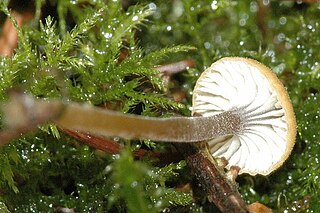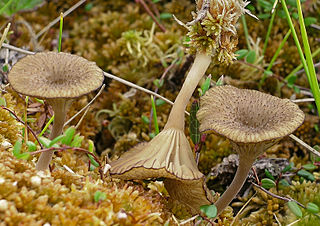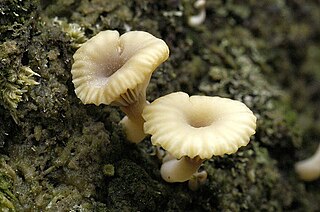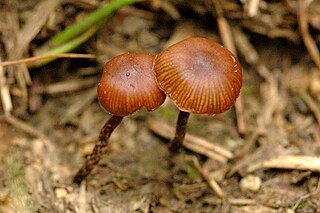
The fungal order Agaricales, also known as gilled mushrooms or euagarics, contains some of the most familiar types of mushrooms. The order has 33 extant families, 413 genera, and over 13,000 described species, along with six extinct genera known only from the fossil record. They range from the ubiquitous common mushroom to the deadly destroying angel and the hallucinogenic fly agaric to the bioluminescent jack-o-lantern mushroom.

The Hymenochaetales are an order of fungi in the class Agaricomycetes. The order in its current sense is based on molecular research and not on any unifying morphological characteristics. According to one 2008 estimate, the Hymenochaetales contain around 600 species worldwide, mostly corticioid fungi and poroid fungi, but also including several clavarioid fungi and agarics. Species of economic importance include wood decay fungi in the genera Phellinus and Inonotus sensu lato, some of which may cause losses in forestry. Therapeutic properties are claimed for Inonotus obliquus ("chaga") and Phellinus linteus, both of which are now commercially marketed.

The Hygrophoraceae are a family of fungi in the order Agaricales. Originally conceived as containing white-spored, thick-gilled agarics, including Hygrophorus and Hygrocybe species, DNA evidence has extended the limits of the family, so it now contains not only agarics, but also basidiolichens and corticioid fungi. Species are thus diverse and are variously ectomycorrhizal, lichenized, associated with mosses, or saprotrophic. The family contains 25 genera and over 600 species. None is of any great economic importance, though fruit bodies of some Hygrocybe and Hygrophorus species are considered edible and may be collected for sale in local markets.

Rickenella is a genus of brightly colored bryophilous agarics in the Hymenochaetales that have an omphalinoid morphology. They inhabit mosses on mossy soils, peats, tree trunks and logs in temperate regions of both the Northern and Southern Hemispheres. Phylogenetically related agarics are in the genera Contumyces, Gyroflexus, Loreleia, Cantharellopsis and Blasiphalia, as well as the stipitate-stereoid genera Muscinupta and Cotylidia. and the clavarioid genus, Alloclavaria.

Loreleia is a genus of brightly colored agarics in the Hymenochaetales that have an omphalinoid morphology. They inhabit mosses and or liverworts on soil in temperate regions of the Northern Hemisphere. Phylogenetically related agarics are in the genera Contumyces, Gyroflexus, Rickenella, Cantharellopsis and Blasiphalia, as well as the stipitate-stereoid genera Muscinupta and Cotylidia and the clavaroid genus, Alloclavaria. However, the large number of DNA base-pair changes causes a long-branch to form in phylogenetic analyses depicted as cladograms.
Cantharellopsis is a tan- to whitish-colored bryophilous monotypic genus in the Hymenochaetales. The fruit bodies of the single species Cantharellopsis prescotii has a form intermediate between an Omphalina and a chanterelle (Cantharellus) because of its forked, fold-like gills. It inhabits moss on calcareous soils in temperate regions of Europe. Phylogenetically related agarics are in the genera Contumyces, Gyroflexus, Loreleia, Rickenella and Blasiphalia, as well as the stipitate-stereoid genera Muscinupta and Cotylidia and the clavarioid genus, Alloclavaria.

Omphalina is a genus of small agarics with white, nonamyloid, basidiospores and decurrent gills. Typically the cap has a deep central depression giving the umbrella-like to funnel-shaped cap the appearance of a belly button, or a belly with a navel. Similarly-shaped agarics are said to be omphalinoid in appearance.

Gerronema is a genus of small- to medium-sized lignicolous agarics with white, nonamyloid, spores and decurrent gills. The genus was circumscribed by American mycologist Rolf Singer in 1951.

Lichenomphalia is both a basidiolichen and an agaric genus. Most of the species have inconspicuous lichenized thalli that consist of scattered, small, loose, nearly microscopic green balls or foliose small flakes containing single-celled green algae in the genus Coccomyxa, all interconnected by a loose network of hyphae. The agaric fruit bodies themselves are nonlichenized and resemble other types of omphalinoid mushrooms. These agarics lack clamp connections and do not form hymenial cystidia. The basidiospores are hyaline, smooth, thin-walled, and nonamyloid. Most of the species were originally classified in the genera Omphalina or Gerronema. Historically the species were classified with those other genera in the family, the Tricholomataceae together with the nonlichenized species. Lichenomphalia species can be grouped into brightly colored taxa, with vivid yellow and orange colors, versus the grey brown group, depending upon the microscopic pigmentation deposits. Molecular research comparing DNA sequences now place Lichenomphalia close to the redefined genus Arrhenia, which together with several other genera not traditionally considered to be related, fall within the newly redefined Hygrophoraceae.

Arrhenia is a genus of fungi in the family Hygrophoraceae. Arrhenia also includes species formerly placed in the genera Leptoglossum and Phaeotellus and the lectotype species itself has an unusual growth form that would not normally be called agaricoid. All of the species grow in association with photosynthetic cryptogams such as mosses, including peat moss, and alga scums on decaying wood, and soil crusts consisting of mixes of such organisms. Typically the fruitbodies of Arrhenia species are grey to black or blackish brown, being pigmented by incrusting melanized pigments on the hyphae.

Deconica montana, commonly known as the mountain moss Psilocybe, is a common species of mushroom that usually grows in mossy and montane regions around the world. The appearance is that of a typical "little brown mushroom" with a small, brown cap and a straight, thin stipe.

Mythicomyces is a fungal genus in the family Mythicomycetaceae. A monotypic genus, it contains the single species Mythicomyces corneipes, first described by Elias Fries in 1861. The fungus produces fruit bodies with shiny yellowish-orange to tawny caps that are 1–3 cm (0.4–1.2 in) in diameter. These are supported by stems measuring 2–5.7 cm (0.8–2.2 in) long and 1–2 mm thick. A rare to uncommon species, it is found in northern temperate regions of North America and Europe, where it typically fruits in groups, in wet areas of coniferous forests. There are several species with which M. corneipes might be confused due to a comparable appearance or similar range and habitat, but microscopic characteristics can be used to reliably distinguish between them.

Collybia is a genus of mushrooms in the family Tricholomataceae. The genus has a widespread but rare distribution in northern temperate areas, and contains three species that grow on the decomposing remains of other mushrooms.

Infundibulicybe is a genus of fungi that is robustly placed incertae sedis as sister group to the Tricholomatoid clade. It has previously been part of the family of Tricholomataceae, but recent molecular phylogeny has shown it to take an isolated position within the Agaricales.

Panellus is a genus of more than 50 mushroom species of fungi in the family Mycenaceae as defined molecularly. Prior to molecular analyses the generic name had been used for any white-spored pleurotoid with amyloid spores. Unrelated but similar species are now classified in Sarcomyxa and Scytinotus. In older guides and other literature the type species had been placed in either Pleurotus or Panus and the poroid species had been classified in the synonymous genus Dictyopanus or in broadly defined genera like Polyporus (Polyporaceae) or the more closely allied Favolaschia (Mycenaceae). The closest molecular allies are Resinomycena and Cruentomycena.

Ampulloclitocybe is a genus of three species of fungi with a widespread distribution.

Collybia cirrhata is a species of fungus in the family Tricholomataceae of the order Agaricales. The species was first described in the scientific literature in 1786, but was not validly named until 1803. Found in Europe, Northern Eurasia, and North America, it is known from temperate, boreal, and alpine or arctic habitats. It is a saprobic species that grows in clusters on the decaying or blackened remains of other mushrooms. The fruit bodies are small, with whitish convex to flattened caps up to 11 mm in diameter, narrow white gills, and slender whitish stems 8–25 mm long and up to 2 mm (0.08 in) thick. C. cirrhata can be distinguished from the other two members of Collybia by the absence of a sclerotium at the base of the stem. The mushroom, although not poisonous, is considered inedible because of its insubstantial size.

Lichenomphalia umbellifera or the green-pea mushroom lichen is a species of basidiolichen in the family Hygrophoraceae. It is regarded as nonpoisonous.

Arrhenia chlorocyanea, commonly known as the verdigris navel, is a species of agaric fungus in the family Hygrophoraceae. Originally named as a species of Agaricus in 1885, and later classified as a member of Omphalina, the species was transferred to the genus Arrhenia in 2002. It is found in Europe and North America.

Lichenomphalia chromacea is a species of basidiolichen in the family Hygrophoraceae. It is found in southern Australia. The yellow-orange fruiting bodies of the species are mushroom-like, with a cap width of typically less than 4 cm. The thallus of the lichen is a greenish, granular layer of fungal hyphae and algae on the soil around the base of the stipe.


















